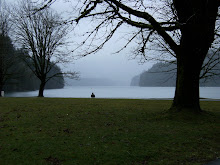Ueshiba was a martial genius. When I want to tease aikidoka I just say, "Aikido is what happens when a really good jujutsuka gets religion." But Ueshiba himself was a martial genius. Don't let the pictures of the little old elf fool you. In his younger days he was a very dangerous man, trained by a very dangerous and vicious man. He was not a theoretician and experienced a significant amount of close quarters combat- he has even described some of the things I think of as "twilight zone stuff", things, such as seeing bullets in flight, that happens on the very edge of human experience.
Kano, on the other hand, was a master instructor. He was a good jujutsuka, but first and foremost he was an educator with a vision. The art that he created, judo, was one of the first effective examples of applying modern (at the time) training methodology and learning theory to a martial art.
Ueshiba did get religion in a big way. He had (alert- my conclusions based on my reading and observation, I'm no expert here) seen that the core of his personal and very effective fighting style (in this instance, 'system' is what you are taught, 'style' is how you as an individual fight) was to misdirect and slip forces. Sword, knife, bullet, punch, tackle... all forces. All things that at high enough skill you can simply choose not to be in front of. When he got religion, he saw that this worked for the world too: conflict only exists if you oppose forces. By misdirecting forces you can win, even destroy an opponent without engaging in a clash. Victory without conflict. Aikido was an expression of what Ueshiba had learned in personal combat aimed towards making a better world.
Kano's art has very similar principles. He had less experience (if any) with personal combat. He had much more experience with how things are learned. Judo was Kano's expression of using martial arts to make a better person.
Our style of jujutsu has a few techniques that look like echoes of aikido- spectacular throws based on locks, stuff like that. But each of them is taught as an assassination. They are things you do as you are walking past an unsuspecting victim. The primary training methodology is based on making a trained warrior reflexively kill when surprised or suddenly 'disadvantaged' (there isn't a good word for it- when a weapon breaks or you are disarmed or, more modern, when you expected your gun to go 'BANG' and it went 'click' the common reaction is to stop and stare at it for a second... and die). Most of the techniques fit this model and are 'rougher' than the assassination techniques.
Working out last night- close and spine control (it can be an immobilization, a takedown or a kill) Close and spine control. Close and spine control. Stan (one of my favorite martial artists and teachers- primarily Small Circle but he has done many other things) noticed that because of flukes of distancing, many students were in a position for one of the aikido-like throws, but no one was going for it.
I approved. There are ways to use the principles of aikido- all good fighters use them, whether they know it or not- but the techniques, especially as echoed in our style, demand perfection. There is no room for mistake in snatching the weapon hand of an armed man out of the air and throwing him. There are some that will say it is not possible. It is possible, but it is hard as hell and there is no room for error. For the style founded by Futagami, who had no interest as far as I know in making a better world or a better person, just a more efficient killer, slop is built in to it. We use the techniques, but we use them from surprise. When the threat is unsurprised or we are recovering from surprise the techniques are "grosser' more respectful of the slop, chaos and mistakes that make up most fights.
Subscribe to:
Post Comments (Atom)



2 comments:
Rory,
Could you define spine control?
Mike
Mmmmm, controlling the spine? Using the wonderful system of ligaments such that pressure on a specific vector coupled with immobilizing another part of the spine makes it very difficult for someone to move.
If you want an attempt at a more detailed explanation, e-mail me (or give me your e-mail privately on one of the BBSs). Really, though this is much easier to learn by sight or feel than by words.
Post a Comment